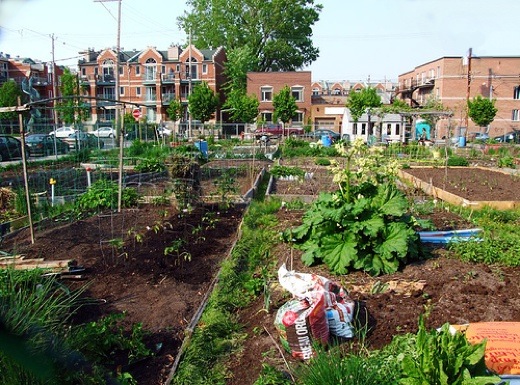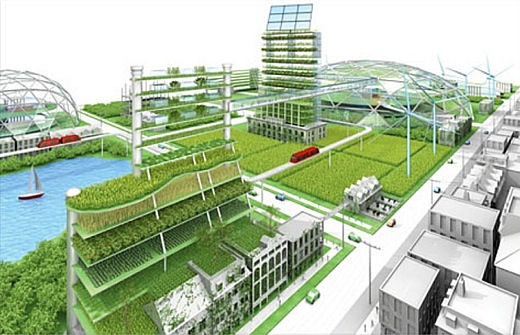SUBHEAD: Detroit’s demise sets up rebirth from grassroots that is now threatened by government and developers.
By Joshua Long 6 April 2011 for Bloomberg News -
(http://www.bloomberg.com/news/2011-04-06/detroit-s-fall-sets-up-rebirth-from-grassroots-commentary-by-joshua-long.html)

Image above: The reality on the ground. People growing food in open lots in their Detroit neighborhoods. From (http://www.celsias.com/article/urban-agriculture-career-path).
These days it seems impossible to write about Detroit in measured terms. Words like “war zone,” “post-apocalyptic” and “ghost town” are often used. Stories portray it as a dystopian landscape of crumbling Gilded Age monuments, abandoned warehouses and overgrown vacant lots. Recent census data confirms that residents are moving out as fast as wildlife is moving in. A sympathetic tone of urban social Darwinism permeates most of these stories, eulogizing a once-vibrant city that was either unable or unwilling to evolve in a globalized post-industrial economy.
Experts argue over whether it was neoliberal class warfare or corrupt government that crippled Detroit. The more than 713,000 remaining inhabitants are frequently portrayed as either hardy veterans of economic fallout or as the left behind victims who couldn’t escape the catastrophe. Meanwhile, they go on living.
Throughout the past decade of job loss and economic decline, residents forged neighborhood alliances, organized community revitalization initiatives, and reshaped Detroit’s landscape in a way that challenges traditional redevelopment doctrine.
Hundreds of grassroots coalitions and nonprofits are doing everything from lot reclamation to microcredit financing and urban farming. Small business is playing its part as well. With low overhead and plenty of niche markets to fill, entrepreneurs are opening independent, locally owned grocery stores, movie theaters, bicycle rental shops and bookstores. On the Rebound There is more than enough evidence to show that Detroit is poised for a comeback.
Not the rapid growth promised by the auto industry or newly elected politicians or Eminem. But the city is on the rise. Please don’t misunderstand me. I’m not trying to paint a rosy picture of contemporary Detroit. The problems that have historically beset the city still exist -- drug use, violent crime, unemployment, the Lions’ decade-long losing streak. Figures show that many of those who were able to escape these problems have done so.
The 25 percent loss in Detroit’s population that has occurred since 2000 has had a ripple effect across the urban landscape. According to recent census data, there are about 80,000 vacant lots in the city. Local officials see the deserted land and homes as potential hotspots for crime and sources of neighborhood blight. So, while the number of vacancies and foreclosures has increased, so have the demolitions. The 2000s saw almost 25,000 housing units disappear.

Image above: Rendering of unrealistic Detroit urban farming by those promoting top down solutions. From (http://gas2.org/2010/01/22/detroit-from-motor-city-to-urban-farm/).
Teardown Strategy
When Mayor Dave Bing took office in May 2009, he announced an ambitious plan to continue the downsizing by demolishing 10,000 buildings in four years. The Obama administration, through the Neighborhood Stabilization Program, has allocated $20 million for such projects.
Meanwhile, the mayor has turned to partnerships with banks and private developers to finance revitalization schemes. The scale and urgency of demolitions is being questioned by some residents. Blight removal is happening too quickly to consider input from community stakeholders, according to several neighborhood groups.
Decisions about razing property and infill development are coming from the top down. Demolition is occurring just as groups of urban designers and architects draw up plans for the new Detroit, a post- industrial city reliant on high-technology employment, regional public transportation, and a sleeker, greener auto industry.
Citizen Concerns
Rapidly implemented master plans like these are the sort of responses that occur when neighborhoods are portrayed as infectious social pariahs. A disastrous narrative invites swift action. Now, residents are concerned that coalitions of local government, private developers and corporate executives are preparing a land grab that could determine a different future for Detroit than the one being forged by grassroots initiatives. I have nothing against architects, planners, developers or corporate executives.
A greener, economically sustainable Detroit depends on their expertise and participation. But I get concerned when I hear alarmist rhetoric used to justify rapid, undemocratic blight removal.
Without the participation of community stakeholders, we quickly descend into the sort of overconfident social engineering projects that scarred urban communities in the 1960s. The last 50 years have shown that Detroit won’t benefit from large-scale actions by the municipal or federal government. Residents have discovered that real recovery comes from community initiatives, entrepreneurial creativity and citizen involvement.
Ground-Level Action
Groups like the Detroit Food Justice Task Force are educating the community about food access and nutrition while networking with entrepreneurs to build a locally sustainable, environmentally just food system. Projects like Hush House are tackling issues of adult illiteracy and homelessness while Urban Neighborhood Initiatives is encouraging rehabilitation of parks, vacant lots and community centers. Greening of Detroit, Detroiters Working for Environmental Justice, and Food and Water Watch are each working to promote equal access to clean water, air and open space for minority populations that historically have suffered disproportionately from exposure to pollution, dumping and waste sites.
These are just a few examples of the type of community cooperation that is building a new urban economy from the bottom-up. Stories about the auto industry and high-tech manufacturing will continue to dominate headlines about Detroit’s future.
But while these industries remain tied to national trends, the grassroots economy continues to build a city by Detroiters for Detroiters. This is welcome news for a region whose livelihood has long been dependent on auto manufacturing and government programs. An economy that relies on local actors and slow growth isn’t sensational, but it is democratic and viable.
Detroit may never again become America’s industrial giant, but it might be entering a new period of sustainable economic development. (Joshua Long, an assistant professor of social sciences at Franklin College Switzerland, is the author of “Weird City: Sense of Place and Creative Resistance in Austin, Texas.”)
.
By Joshua Long 6 April 2011 for Bloomberg News -
(http://www.bloomberg.com/news/2011-04-06/detroit-s-fall-sets-up-rebirth-from-grassroots-commentary-by-joshua-long.html)

Image above: The reality on the ground. People growing food in open lots in their Detroit neighborhoods. From (http://www.celsias.com/article/urban-agriculture-career-path).
These days it seems impossible to write about Detroit in measured terms. Words like “war zone,” “post-apocalyptic” and “ghost town” are often used. Stories portray it as a dystopian landscape of crumbling Gilded Age monuments, abandoned warehouses and overgrown vacant lots. Recent census data confirms that residents are moving out as fast as wildlife is moving in. A sympathetic tone of urban social Darwinism permeates most of these stories, eulogizing a once-vibrant city that was either unable or unwilling to evolve in a globalized post-industrial economy.
Experts argue over whether it was neoliberal class warfare or corrupt government that crippled Detroit. The more than 713,000 remaining inhabitants are frequently portrayed as either hardy veterans of economic fallout or as the left behind victims who couldn’t escape the catastrophe. Meanwhile, they go on living.
Throughout the past decade of job loss and economic decline, residents forged neighborhood alliances, organized community revitalization initiatives, and reshaped Detroit’s landscape in a way that challenges traditional redevelopment doctrine.
Hundreds of grassroots coalitions and nonprofits are doing everything from lot reclamation to microcredit financing and urban farming. Small business is playing its part as well. With low overhead and plenty of niche markets to fill, entrepreneurs are opening independent, locally owned grocery stores, movie theaters, bicycle rental shops and bookstores. On the Rebound There is more than enough evidence to show that Detroit is poised for a comeback.
Not the rapid growth promised by the auto industry or newly elected politicians or Eminem. But the city is on the rise. Please don’t misunderstand me. I’m not trying to paint a rosy picture of contemporary Detroit. The problems that have historically beset the city still exist -- drug use, violent crime, unemployment, the Lions’ decade-long losing streak. Figures show that many of those who were able to escape these problems have done so.
The 25 percent loss in Detroit’s population that has occurred since 2000 has had a ripple effect across the urban landscape. According to recent census data, there are about 80,000 vacant lots in the city. Local officials see the deserted land and homes as potential hotspots for crime and sources of neighborhood blight. So, while the number of vacancies and foreclosures has increased, so have the demolitions. The 2000s saw almost 25,000 housing units disappear.

Image above: Rendering of unrealistic Detroit urban farming by those promoting top down solutions. From (http://gas2.org/2010/01/22/detroit-from-motor-city-to-urban-farm/).
Teardown Strategy
When Mayor Dave Bing took office in May 2009, he announced an ambitious plan to continue the downsizing by demolishing 10,000 buildings in four years. The Obama administration, through the Neighborhood Stabilization Program, has allocated $20 million for such projects.
Meanwhile, the mayor has turned to partnerships with banks and private developers to finance revitalization schemes. The scale and urgency of demolitions is being questioned by some residents. Blight removal is happening too quickly to consider input from community stakeholders, according to several neighborhood groups.
Decisions about razing property and infill development are coming from the top down. Demolition is occurring just as groups of urban designers and architects draw up plans for the new Detroit, a post- industrial city reliant on high-technology employment, regional public transportation, and a sleeker, greener auto industry.
Citizen Concerns
Rapidly implemented master plans like these are the sort of responses that occur when neighborhoods are portrayed as infectious social pariahs. A disastrous narrative invites swift action. Now, residents are concerned that coalitions of local government, private developers and corporate executives are preparing a land grab that could determine a different future for Detroit than the one being forged by grassroots initiatives. I have nothing against architects, planners, developers or corporate executives.
A greener, economically sustainable Detroit depends on their expertise and participation. But I get concerned when I hear alarmist rhetoric used to justify rapid, undemocratic blight removal.
Without the participation of community stakeholders, we quickly descend into the sort of overconfident social engineering projects that scarred urban communities in the 1960s. The last 50 years have shown that Detroit won’t benefit from large-scale actions by the municipal or federal government. Residents have discovered that real recovery comes from community initiatives, entrepreneurial creativity and citizen involvement.
Ground-Level Action
Groups like the Detroit Food Justice Task Force are educating the community about food access and nutrition while networking with entrepreneurs to build a locally sustainable, environmentally just food system. Projects like Hush House are tackling issues of adult illiteracy and homelessness while Urban Neighborhood Initiatives is encouraging rehabilitation of parks, vacant lots and community centers. Greening of Detroit, Detroiters Working for Environmental Justice, and Food and Water Watch are each working to promote equal access to clean water, air and open space for minority populations that historically have suffered disproportionately from exposure to pollution, dumping and waste sites.
These are just a few examples of the type of community cooperation that is building a new urban economy from the bottom-up. Stories about the auto industry and high-tech manufacturing will continue to dominate headlines about Detroit’s future.
But while these industries remain tied to national trends, the grassroots economy continues to build a city by Detroiters for Detroiters. This is welcome news for a region whose livelihood has long been dependent on auto manufacturing and government programs. An economy that relies on local actors and slow growth isn’t sensational, but it is democratic and viable.
Detroit may never again become America’s industrial giant, but it might be entering a new period of sustainable economic development. (Joshua Long, an assistant professor of social sciences at Franklin College Switzerland, is the author of “Weird City: Sense of Place and Creative Resistance in Austin, Texas.”)
.
No comments :
Post a Comment